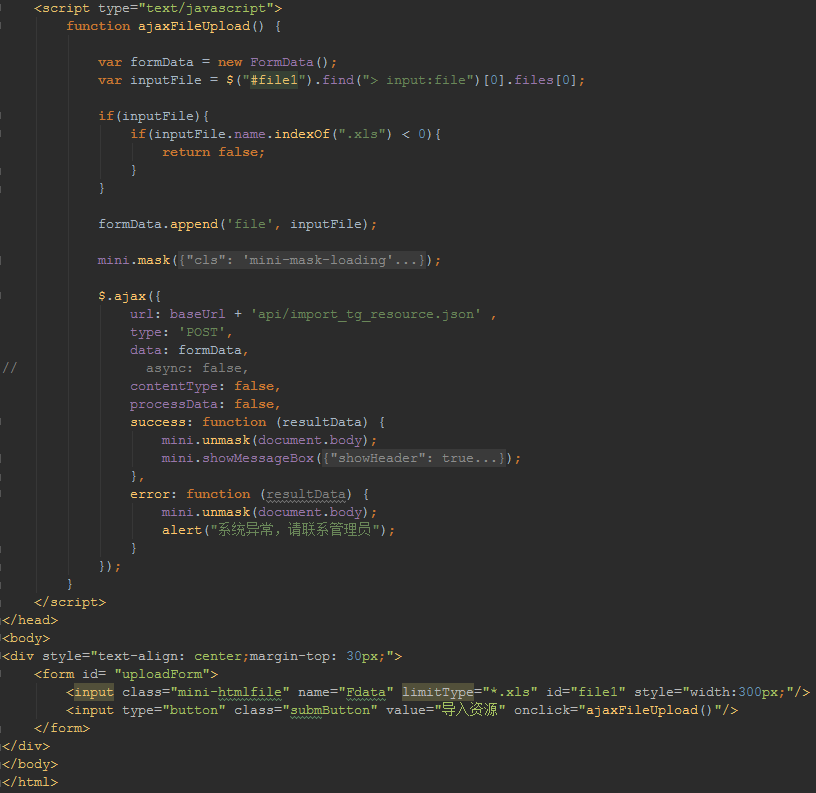FormData对象,是可以使用一系列的键值对来模拟一个完整的表单,然后使用XMLHttpRequest发送这个"表单"。 在 Mozilla Developer 网站 使用FormData对象 有详尽的FormData对象使用说明。 但上传文件部分只有底层的XMLHttpRequest对象发送上传请求,那么怎么通过jQuery的Ajax上传呢? 本文将介绍通过jQuery使用FormData对象上传文件。
使用<form>表单初始化FormData对象方式上传文件
HTML代码
<form id="uploadForm" enctype="multipart/form-data">
<input id="file" type="file" name="file"/>
<button id="upload" type="button">upload</button>
</form>
javascript代码
$.ajax({
url: '/upload',
type: 'POST',
cache: false,
data: new FormData($('#uploadForm')[0]),
processData: false,
contentType: false
}).done(function(res) {
}).fail(function(res) {});
这里要注意几点:
- processData设置为false。因为data值是FormData对象,不需要对数据做处理。
-
<form>标签添加enctype="multipart/form-data"属性。
- cache设置为false,上传文件不需要缓存。
- contentType设置为false。因为是由<form>表单构造的FormData对象,且已经声明了属性enctype="multipart/form-data",所以这里设置为false。
上传后,服务器端代码需要使用从查询参数名为file获取文件输入流对象,因为<input>中声明的是name="file"。 如果不是用<form>表单构造FormData对象又该怎么做呢?
使用FormData对象添加字段方式上传文件
HTML代码
<div id="uploadForm">
<input id="file" type="file"/>
<button id="upload" type="button">upload</button>
</div>
这里没有<form>标签,也没有enctype="multipart/form-data"属性。 javascript代码
var formData = new FormData();
formData.append('file', $('#file')[0].files[0]);
$.ajax({
url: '/upload',
type: 'POST',
cache: false,
data: formData,
processData: false,
contentType: false
}).done(function(res) {
}).fail(function(res) {});
这里有几处不一样:
- append()的第二个参数应是文件对象,即$('#file')[0].files[0]。
- contentType也要设置为‘false’。 从代码$('#file')[0].files[0]中可以看到一个<input type="file">标签能够上传多个文件, 只需要在<input type="file">里添加multiple或multiple="multiple"属性。

后台接收文件:
<bean id="multipartResolver" class="org.springframework.web.multipart.commons.CommonsMultipartResolver">
<property name="defaultEncoding" value="utf-8"/>
</bean>
@RequestMapping(value = "/import_tg_resource")
public ModelAndView import_tg_resource(@RequestParam(value = "file", required = false) MultipartFile[] files, HttpServletRequest request, ModelMap model) {
System.out.println("开始批量上传:文件数量:" + files.length);
for (MultipartFile file : files ) {
String path = request.getSession().getServletContext().getRealPath("upload");
String fileName = file.getOriginalFilename();
String prefix = fileName.substring(fileName.lastIndexOf("."));
fileName = new Date().getTime() + prefix;
// System.out.println("保存路径 " + path);
File targetFile = new File(path, fileName);
if(!targetFile.exists()){
targetFile.mkdirs();
}
file.transferTo(targetFile);
}
}
来源:oschina
链接:https://my.oschina.net/u/152736/blog/743670